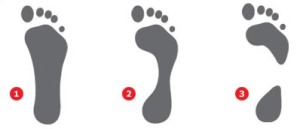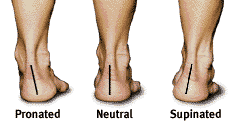Have you ever gone on a run and come back with horrible, aching feet? Chances are, you’re in the wrong shoes! These days, there are so many shoes out there that it’s hard to know which ones are going to be the best ones for YOU. That’s why we here at GH Sports offer a complimentary gait analysis to help fit customers to their perfect shoe. Let’s dive deeper into the steps of a complete gait analysis:
STEP 1: Arch Height
The first thing we do for the gait analysis is take an imprint of each of your feet to measure your arch height. People’s arch heights are either low, medium, or high.

It’s important that people with high arches get enough arch support, otherwise injuries – such as collapsed arches – can occur. Running shoes vary in how much arch support they offer. The Mizuno Rider, for example, has a high arch support built into the shoe whereas the Saucony Ride has low arch support. Another option to get proper arch support is to use an orthotic insert. Superfeet Green is specifically designed for high arches. This is good for work shoes or other shoes that don’t quite offer enough support in them (or for lower arched running shoes).
STEP 2: Foot Strike
The next thing we do in the analysis is get you on the treadmill. We’ll either have you walk or run, depending on what you’ll be doing most in the shoes. The foot stike is where you first meet contact with the ground when you plant your foot. People are either a heel, midfoot, or forefoot striker.

Running shoes have what’s called a “drop,” which is the difference between the heel height and the forefoot height. The Asics 2000 has a heel height of 21mm and a forefoot height of 11mm, which therefore gives it a 10mm drop. Shoes with a higher drop have more cushion in heel than the rest of the shoe. A shoe with a lower drop, such as the Saucony Mirage with a 4mm drop, has a more even cushion distribution.
The reason this is of importance is because a shoe with a higher drop is good for a heel striker, whereas a shoe with a lower drop and a more even cushion distribution is good for a midfoot/forefoot striker.
STEP 3: Pronation
The other thing we look for when you’re on the treadmill is for pronation. People pronate when their ankle rolls inward as they plant and step off of the ground.

Leave a Reply